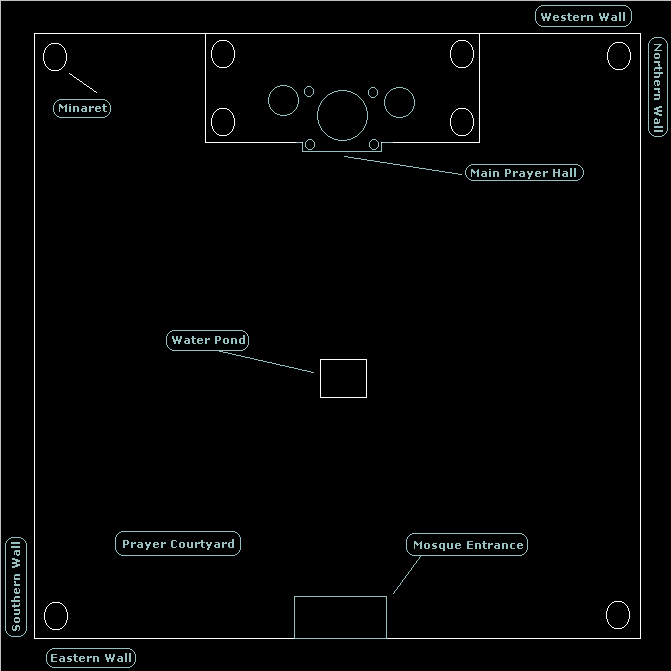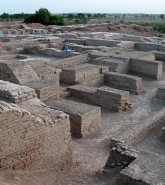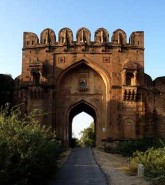
Badshahi Mosque (transformation in English: Royal Mosque) is the second largest mosque of Pakistan, located in provincial capital Lahore of Punjab. It was built in 1673 A.D. by the sixth Mughal Emperor Aurangzeb Alamgir. The mosque remained the largest mosque of the world from 1673 to 1986, when it was overtaken in capacity and size upon the completion of Shah Faisal Mosque in Islamabad. It has a total area of 29,867.2 square meters (321, 488 square feet) and can accommodate upto 100,000 worshipers. Now it is 8th largest mosque in the world in terms of its capacity for accommodating worshipers and 10th largest in terms of total area. Badshahi Mosque with its beautiful Mughal architectural style and historical background is a major landmark and tourist attraction not only in Lahore but in whole Punjab.
History:
Construction:
Badshahi Mosque was constructed in Mughal era during the reign of sixth Mughal Emperor Aurangzeb Alamgir. He ordered the construction of Badshahi Mosque in 1671 A.D. For this purpose, he appointed his foster brother Fiadi Khan Koka governor of Lahore, specifically to undertake supervision of the construction work of the mosque. The mosque was completed after two years in 1673 A.D. Fiadi Khan Koka remained the governor of Lahore until 1675 A.D.
Sikh era:
In July 1799, the Sikh militia Maharaja Ranjit Singh conquered Lahore. During the Sikh rule the mosque was badly mistreated and damaged several times. The Sikh Maharaja used the vast courtyard of the mosque as a stable for horses of his army. He also used 80 hujras (study rooms) built around the courtyard as quarters for his soldiers and as storehouses for weapons.
In 1841, a Sikh civil war was provoked between Sher Singh (son of Ranjeet Singh) and Maharani Chand Kaur. During the war Sher Singh used the minarets of Badshahi Mosque to place light guns called Zamburahs to bombard the supporters of Maharni who took refuge in Shahi Qila.
British era:
In the middle of 18th century after British took over the Lahore, the British East India Company continued to use the mosque for military purposes. They demolished the 80 hujras (study rooms) around the courtyard of the mosque to prevent them for being used against British and rebuilt to create dalans (side aisles) which are still there.
In 1952 the British leadership in India sensed the increasing resentment in Muslims against the use of Badshahi Mosque for military purposes, so they created Badshahi Mosque Authority for restoration of the mosque to its original form and returning to Muslims.
Later in 1939 A.D. the Badshahi Mosque Authority started extensive repair work to restore the mosque.
Badshahi Mosque under Pakistan:
After the independence of Pakistan in 1947, Lahore became a part of Pakistan and so Badshahi Mosque with it. The restoration of the mosque started in 1939 by Badshahi Mosque Authority remained continue, until the mosque was restored to its original condition in 1960 with a total cost of 5.8 million rupees.
Later Fakir Family of Lahore donated relics of Prophet Muhammad, his daughter Fatima and his cousin Ali to Badshahi Mosque. The Government of Pakistan used these relics to set up a museum inside main gateway entrance of Badshahi Mosque.
In 1993, the Government of Pakistan proposed the consideration of the Badshahi Mosque as a UNESCO World Heritage Site, where it has been added to Pakistan’s Tentative List for possible nomination to the World Heritage List.
In 2000, repair work was done to the marble inlay of Badshahi Mosque.
In 2008, the red sandstone tiles of Badshahi Mosque’s large courtyard were replaced. The sandstone used for this replacement was imported form a place near Jaipur, Rajasthan in India which was original source of the sandstone used when the mosque was constructed back in 1673.
Design and Architecture:
The design and architecture of Badshahi Mosque was inspired by Islamic, Centeral Asian, Persian, and Indian architectural designs. The design of Badshahi Mosque is nearly similar to Jama Mosque of Delhi which was constructed by Aurangzeb Alamgir’s father Emperor Shah Jahanin1648 A.D.
Badshahi Mosque and its vast courtyard are built upon a platform which is accessed from the east using 22 three-sided steps and graceful gateway of traditional Mughal style.
The Main Prayer Hall of Badshahi Mosque has a total area of 22, 825 sq. feet (2120 sq. meters). Its interior is richly decorated with inlaid marble, fresco work, and stucco tracery. The exterior of Main Prayer Hall is embellished with stone carvings and marble inlay on red sandstone.
The courtyard has a total area of 278, 784 sq. feet (25, 899.9 sq. meters). The present red sandstone flooring on courtyard was laid during the major renovation work done by Badshahi Mosque Authority (1939-60). Originally it was decorated with small kiln-burnt bricks laid in Mussalah Pattern.
The mosque has four corner minarets; each has a height of 176 feet (53.75 meters) and 67 feet (20 meter) circumference.
The central dome has 70 feet 6 inches (21.49 meters) diameter at bugling and it is 49 feet (15 meter) high. The mosque has also two smaller domes, one on each side of large dome. Each small dome has 54 feet (16.36 meter) diameter at bugling and a height of 32 feet (9.8 meters).







